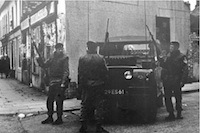
The geographical and symbolic position of St Matthew’s Church, facing on to the staunchly loyalist Newtownards Road, played a major factor in the events which were to unfold in June 1970.
The history of street confrontations between the Catholic residents of the tiny Short Strand enclave and the surrounding loyalist areas stretched back to the pogroms of the 1920s.
Between 1920 and 1922 more than 40 people had been shot dead in the immediate vicinity of St Matthew’s in what became known M the Belfast pogroms. Catholics in the Short Strand numbered 6,000, while their loyalist neighbours totalled 60,000.
On the night of June 27, Belfast had been thrown into turmoil following Orange Order marches across the north and west of the city.
Three Protestants had been shot dead during serious sectarian clashes in north Belfast that afternoon.
That evening, as rioting spread across the city, the British army was nowhere to be seen.
The violence began when a loyalist mob attempted to burn down St Matthew’s.
Stormont MP Paddy Kennedy led a deputation of Short Strand residents to the area’s RUC station to demand protection for their homes.
Even though a British Army company did eventually arrive, it failed to intervene.
The ensuing gun battle between the IRA and loyalists, which became known as the Battle of St Matthew’s, is regarded as the IRA’s first major engagement of the conflict.
The decision of Belfast IRA leader Billy McKee and members of a local defence committee to physically defend the Short Strand with a handful of weapons would later be seen as a crucial turning point in the growth of the Provisional IRA.
The gun battle around St Matthew’s lasted live hours and republicans fired 800 rounds.
The following morning three men, two Protestant and one Catholic, lay dead, and dozens were injured.
Vol. Henry Mcllhone died following a two-day fight for life.
Highlighting the British army’s reluctance to get involved, BBC journalist Peter Taylor later said: “The shooting intensified but the soldiers still declined to intervene and separate the two sides, either because they felt they were not numerically strong enough or did not wish to get caught up in the middle of a sectarian fight, in the darkness, with shots being fired by both sides.”
The British army’s Colonel Mike Dew later claimed loyalists had prevented the British Army from reaching the area.
“The whole incident had taken its course because the army was so chronically overstretched that night in Belfast,” he said.
“One spare battalion in the whole of west Belfast was not able to get through Protestants to the Short Strand area.
“In all [the British army general officer commanding Sir lan] Freeland had barely two battalions in the city.
“It was too little too late.”
Billy McKee, who was himself shot five times during the gun battle, has recently recounted events to counter claims that Mr Mcllhone was shot by IRA informer Denis Donaldson. Donaldson was outed as a British agent in 2005 and killed in 2006.
Mr McKee described how he told Henry McIlhone to take up a position around St Matthew’s Church. He recalled that he was just yards from the local man when he was mortally wounded and said the loyalists who shot him and Henry were as close as “two or three feet” from him as he leaned wounded against a wall.
The loyalist gunmen opened fire on him again and left him for dead and from their close proximity Billy McKee is able to say that neither bore any resemblance to the physically-diminutive Denis Donaldson.
While the gun battle would go on for five hours, there were initially few casualties.
According to Liz Maskey, then a first aid worker with the Order of Malta, that all changed when McKee and McIlhone were carried into the school.
“It was the first time I’d ever seen anyone with gunshot wounds,” she said.
“Billy McKee had been shot five times but was conscious the whole time. But poor Henry Mclhone was in a much worse condition.
“We did what we could for them both but it was obvious that they needed to get to hospital so our ambulance tried to get them to the Mater.
“But the Short Strand was completely surrounded by loyalists and the ambulance was attacked as it tried to leave the area. It had to drive without its lights on and take a major detour but eventually they made it to the Mater.
“Unfortunately Henry McIlhone died two days later.”
While relative calm was eventually restored the followingd ay, life would never be the same for Liz McKee.
In January 1973 she became the first female internee and took part in an attempt to escape from Armagh prison.
She went on to marry and have a family with her husband, high-profile Sinn Fein South Belfast Assembly member Alex Maskey.
Reflecting on events she said: “ Like a lot of other young men and women I decided that I had to do something about the injustices that were going on.”
A young Jim Gibney recalled how events in the Short Strand had led to a rebirth of the IRA.
“l saw neighbours, people I knew, coming down the street carrying rifles,” he said.
“I was just dumbstruck by this experience.
“I’d never seen such a thins before.
“I think it added to the rebirth of the IRA and fitted in with the emergence of the IRA as a defensive force in nationalist Belfast.
“That’s its significance.
“Had the IRA and the Citizens’ Defence Committees not been on the streets, then I believe Short Strand would have been razed that night.”
![[Irish Republican News]](https://republican-news.org/graphics/title_gifs/rn.gif)
![[Irish Republican News]](https://republican-news.org/graphics/title_gifs/harp.gif)

